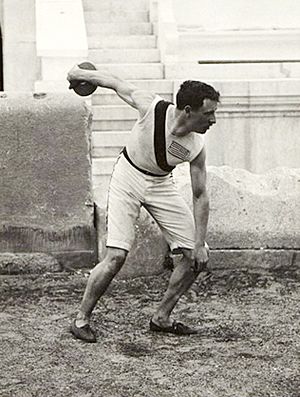Robert Garrett facts for kids
 |
|||||||||||||||||||||||||||||
| Personal information | |||||||||||||||||||||||||||||
|---|---|---|---|---|---|---|---|---|---|---|---|---|---|---|---|---|---|---|---|---|---|---|---|---|---|---|---|---|---|
| Born | May 24, 1875 Baltimore County, Maryland |
||||||||||||||||||||||||||||
| Died | April 25, 1961 (aged 85) Baltimore, Maryland |
||||||||||||||||||||||||||||
| Height | 1.88 m (6 ft 2 in) | ||||||||||||||||||||||||||||
| Weight | 81 kg (179 lb; 12.8 st) | ||||||||||||||||||||||||||||
| Sport | |||||||||||||||||||||||||||||
| Sport | Athletics | ||||||||||||||||||||||||||||
|
Medal record
|
|||||||||||||||||||||||||||||
Robert S. Garrett (May 24, 1875 – April 25, 1961) was an American athlete, banker, and generous helper of his community. He is famous for being the first modern Olympic champion in both the discus throw and shot put.
Contents
Robert Garrett's Early Life and Family
Robert S. Garrett was born in Baltimore County, Maryland, into a very rich and important family. His family had run a successful banking and shipping business called Robert Garrett and Sons since 1819. His grandfather, John Work Garrett, was the head of the Baltimore and Ohio Railroad for many years. This railroad was one of the first and most important in America.
Like his older brother, Robert went to Princeton University. There, he was excellent at track and field sports. He was even the captain of Princeton's track team in his junior and senior years. Robert Garrett married Katharine Barker Johnson, and they had five children.
Robert Garrett's Olympic Journey
When Robert Garrett was in college, he was mainly a shot-putter. He also competed in jumping events. In 1896, he decided to go to the first modern Olympic Games in Athens, Greece.
His professor suggested he try the discus throw. Robert tried to make a discus, but it was too heavy (about 30 pounds or 14 kg). He gave up on the idea. Robert paid for himself and three classmates to travel to Athens for the games.
When he arrived in Athens, he found out that a real discus weighed much less, only about five pounds. He decided to enter the event just for fun.
Winning Gold in 1896
There were three Greek discus throwers who had a very graceful style. Robert Garrett, however, threw the discus with a lot of power, like he was throwing a hammer. His first two throws were not good and almost hit people watching. Everyone, including Robert, laughed.
But his last throw was amazing! He threw the discus 19 centimetres (7.5 in) farther than the second-place thrower, Panagiotis Paraskevopoulos. The discus landed at 29.15 metres (95 ft 8 in). Everyone was shocked because a foreigner had won their classic event.
Robert Garrett also won the shot put event with a distance of 11.22 metres (36 ft 10 in). He came in second place in the high jump, tying with James Brendan Connolly at 1.65 metres (5 ft 5 in). He also got second place in the long jump with a jump of 6.00 metres (19 ft 8 in).
Competing in the 1900 Olympics
Four years later, Robert Garrett competed in the 1900 Summer Olympics in Paris. He won a bronze medal in the shot put. He also won a bronze medal in the standing triple jump.
He did not compete in the shot put final because it was on a Sunday, his religious day of rest. But his score from the qualifying round was good enough to earn him third place. He also tried the discus throw again, but all his throws hit trees, so he couldn't get a valid score.
Robert Garrett was also part of the Tug-of-War team in 1900. His team had to drop out because three of its members were busy competing in the hammer throw final at the same time.
Robert Garrett: Banker and Community Helper
After his Olympic career, Robert Garrett became a banker and financier. He worked at his family's company, Robert Garrett and Sons, in Baltimore. He also invested in the B&O Railroad.
Supporting Archeology and Collecting Books
Robert Garrett was very interested in science, especially history and archeology. He helped organize and pay for an archeological trip to Syria. From 1932 to 1939, he helped fund and work on digs in Antioch.
His hobby was collecting old handwritten books, called manuscripts. He gathered a huge collection of historical books and scrolls from all over the world. In 1942, he gave over 11,000 of these manuscripts to Princeton University.
Garrett was a dedicated supporter of Princeton University and served on its board. He was also on the board of the Baltimore Museum of Art. This museum was founded by his aunt, Mary Elizabeth Garrett.
Helping Baltimore's Community
Robert Garrett was a very active leader in Baltimore. He was in charge of the city's Public Improvement Commission. He also played a big role in bringing the Boy Scouts of America to Baltimore in 1910. He managed the Boy Scouts in Baltimore until 1934.
In 1919, Garrett gave a piece of land to the City of Baltimore for a public park. This park, located in the Brooklyn neighborhood, was named Garrett Park in his honor.
He helped create many public recreation places in Baltimore. He started the Public Athletic League, which later joined with the Children's Playground Association. He was the first chairman of Baltimore City's Bureau of Recreation. He also led the City's Board of Park Commissioners.
Robert Garrett was a religious man and was recognized for his work in religious education.
Robert Garrett's Legacy
Robert Garrett passed away on April 25, 1961, in Baltimore, Maryland. He was buried in Baltimore's historic Green Mount Cemetery. The Garrett Park recreation area in Baltimore City is named after him. He also donated his personal papers to Princeton University.
In 1984, a TV show called "The First Olympics: Athens 1896" was made about the first modern Olympic Games. In the show, Robert Garrett was played by actor Hunt Block.
Images for kids
See also
 In Spanish: Robert S. Garrett para niños
In Spanish: Robert S. Garrett para niños



